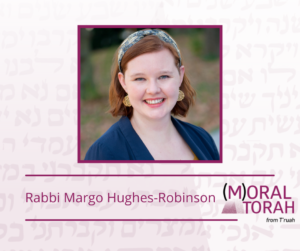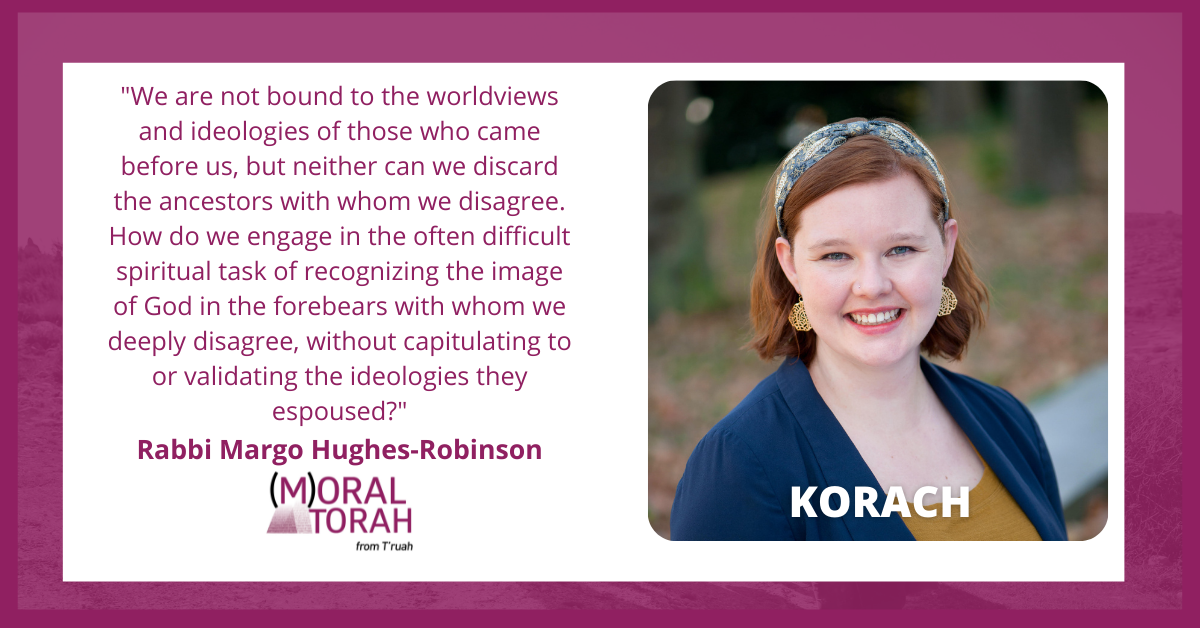A D’var Torah for Parshat Korach by Rabbi Margo Hughes-Robinson
It’s easy to wish we could bury our problems forever. In our parshah this week, the Torah externalizes this desire and expresses it on a scale of existential drama, where the rebel Korach and his supporters are swiftly removed from their conflict with Moses:
“Scarcely had [Korach] finished speaking these words when the ground burst open under them; and the land opened its mouth, swallowed them and their households: every person that was with Korach, and all that they possessed. They went down alive to Sheol [the underworld], with all that belonged to them; the earth closed over them and they vanished from amongst the congregation.” (Numbers 16:31-33)
The horror of this event belies the uncomfortable emotional satisfaction it may reflect. When we look over our own family and community history, we are bound to discover those among our forebears whose choices and worldviews evoke deep pain in us, even shame. In the American Jewish community, we may shrink from remembering figures whose legacies of discrimination tear at our comfortable self-image as standing for justice and human rights: among them the pro-segregation rabbis of the mid-20th century, the violent extremists who drew on Jewish text to justify acts of terror, and even our own departed family members whom we remember fondly, but we know would have espoused painful beliefs about those of us in queer, multifaith, or multiracial relationships.
Sign up to receive (M)oral Torah in your inbox each week.
The power of Korach’s removal lies in the lack of accountability it requires of every other person in the camp: The individuals and their families are suddenly gone, untouched by anyone in the community, and buried under the ground. Reflected in this biblical drama is a powerful fantasy about conflict that does not require any relational grappling, emotional integration, or even calling-in of the community members involved. No one has to rebuke Korach and his band, and their disappearance relieves the Israelites of any responsibility for what has just happened within their community.
Our aggadic tradition, however, prevents us from indulging this fantasy that these people or their legacies magically disappear. Drawing on the Torah text’s insistence that Korach and his band were swallowed in the earth alive, later texts insist that the Korachites — and the communal fracture they represent — are constantly just beneath the surface. Sometimes, they literally bubble up and force later generations to encounter them. In the Talmud (Bava Batra 74a), Rabba bar bar Hanna reports that Korach and his followers are in constant motion in the imagined underworld of Gehenna, roiled around like boiling water as they eternally assert that “Moses and the Torah are true, and they [i.e. we, the Korachites] are liars.”
We are not bound to the worldviews and ideologies of those who came before us, but neither can we discard the ancestors with whom we disagree. How do we engage in the often difficult spiritual task of recognizing the image of God in the forebears with whom we deeply disagree, without capitulating to or validating the ideologies they espoused? What are we to do with the skeletons in the family closet that we cannot ignore? In the traditions surrounding Hannah, who Judaism esteems both as the mother of the prophet Samuel and as the innovator of personal prayer, we are shown a path towards reconciliation of our ethical mandates to validate the divinity of each person without affirming their views or the pain that they have caused.
Find more commentaries on Parshat Korach.
Generations after the Korachites are thrown underground, Hannah marries into this fractious family. Her son Samuel, the Bible notes, is a direct descendant of Korach (1 Chronicles 6:16-18), but in his prophetic career manages to invert his family legacy by speaking truth to corrupt Jewish leadership, chastising King Saul throughout his doomed tenure. What allows this shift in the family legacy to happen, the midrash suggests, is the vital perspective brought by Hannah herself.
In her prayer commemorating the birth and dedication of her son Samuel, Hannah invokes the divine power of potential for change. In her praise, she weaves the circumstances of her own infertility and subsequent pregnancy alongside universal motifs of reversal and restoration: She says God “raises the poor up out of the dust, and lifts up the needy from refuse,” (1 Samuel 2:8) and that God who “deals death and gives life, who casts down to Sheol and raises up.” (1 Samuel 2:6) The midrash in Bereshit Rabbah 98:2 imbues this last phrasing with deep significance, reporting that for generations Korach and his band sunk lower and were churned around below the earth, until Hannah prayed for them and they knew peace. The Korachites are not brought back to life, according to the midrash, but the family legacy bubbling under the surface finally seems to meet resolution.
 In Hannah we encounter a powerful model for the work of intergenerational accountability. Nowhere in Hannah’s prayer is there an apologetic for Korach, nor does she engage in justification or a frantic attempt at historical situating: “It was a different time then!” Instead, Hannah couples acknowledgement of the cosmic consequences of Korach’s ideology and actions — “cast down to Sheol” — with seeking a deeper kind of relationship with the Divine, at the very moment she is fomenting a different path ahead for the family she has joined — dedicating her long-awaited son to the priesthood. As inheritors of the tradition that encompasses both Korach and Hannah, of fracture and of its healing, it is upon us to engage in the same project of ethical reckoning with our family and communal legacies.
In Hannah we encounter a powerful model for the work of intergenerational accountability. Nowhere in Hannah’s prayer is there an apologetic for Korach, nor does she engage in justification or a frantic attempt at historical situating: “It was a different time then!” Instead, Hannah couples acknowledgement of the cosmic consequences of Korach’s ideology and actions — “cast down to Sheol” — with seeking a deeper kind of relationship with the Divine, at the very moment she is fomenting a different path ahead for the family she has joined — dedicating her long-awaited son to the priesthood. As inheritors of the tradition that encompasses both Korach and Hannah, of fracture and of its healing, it is upon us to engage in the same project of ethical reckoning with our family and communal legacies.
Rabbi Margo Hughes-Robinson starts next week as T’ruah’s New York Organizer. She is an alumna of T’ruah’s Israel Fellowship, and was ordained this spring by the Jewish Theological Seminary. She lives in Brooklyn with her wife, Lily.

